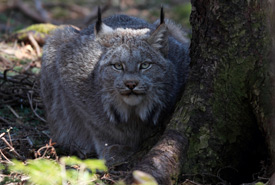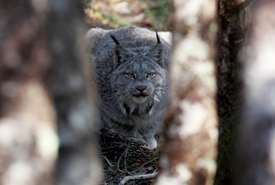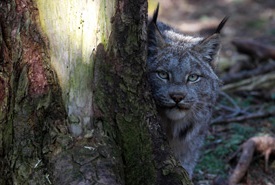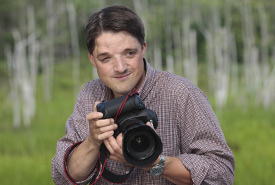Sharing a quiet forest with a Canada lynx

Canada lynx (Photo by Mike Dembeck)
Sitting for hours inside a cramped, cold blind waiting for wildlife doesn't sound exciting — but it is. Being able to observe animals in their natural surroundings isn't just a thrill, it's a passion, and one that doesn't come easy and is often short-lived. There is a lot of work, patience and much disappointment involved, but the results live forever as photos.
Photographing a Canada lynx isn't something you forget. They are unlike any other creature I've seen. Keenly aware and so deeply connected to their environment with their sharp feline senses, they are extremely skittish and always quiet. Plus, as cats, they prefer darkness to daylight for venturing around, so seeing them with a camera is lucky.

Catching a glimpse of a Canada lynx hidden between the trees. (Photo by Mike Dembeck)
The first lynx I photographed took three mornings of waiting before I saw it. Difficult to spot, it slunk low between the shadows of the forest floor, moving with an almost mythical aura that exuded grace and authority.
It was its black-streaked mane poking out from behind a stump that gave it away that morning. Slowly peering around the tree, the lynx immediately looked straight at me with its piercing eyes. Concealed or not, it knew I was there right away. It had been fooled.
The feeling I had was almost instinctual. With a quick gasp, my breathing stopped as I realized what I was looking at. Immediately, I wanted to get my camera up to capture the moment, but knew full well any movement might end this opportunity. Plus, the animal was already aware of me and likely about to flee.
With it staring straight at me I felt obliged to at least acknowledge my presence, hoping it might stay a while longer. I broke our gaze and slowly bowed my head, hoping this would show submissiveness and the lynx wouldn't feel threatened.

The Canada lynx slowly peeks out from behind a tree. (Photo by Mike Dembeck)
It worked. Looking back up, I saw the lynx move out completely from behind the tree’s cover, turn its body to face me and, moving exactly like a house cat, it sat down. This was my chance.
In wildlife photography, the challenge is often silencing the mechanics of the camera. Taking that first picture is often what gives you away and ends the encounter. To an animal, the sound of the shutter is like thunder on a cloudless day — very unnatural and very loud.
Raising my camera to take the shot, I broke the silence of the morning and expected the animal to immediately bolt. Oddly enough, the lynx seemed intrigued by the noise and remained motionless. I took another dozen or so photos before the lynx had finally had enough of me, and it stood up and silently walked off into the trees without any concern. The whole encounter might have only lasted a minute, but that gaze and those eyes will stay with me forever.
Want to support wildlife species and their habitat? With your donation, you are accelerating the pace of conservation and helping find solutions to the twin crises of rapid biodiversity decline and climate change. Learn more >


